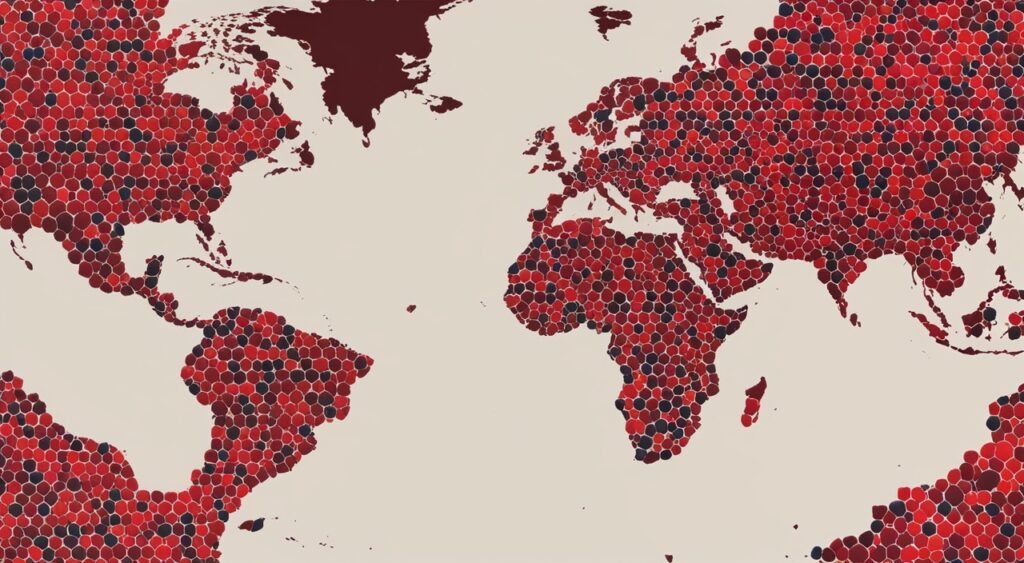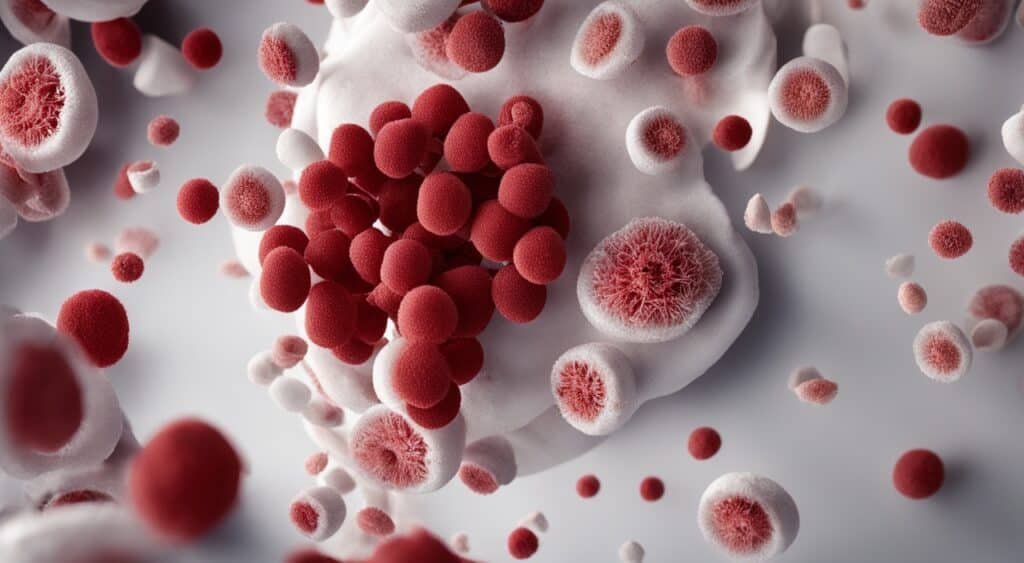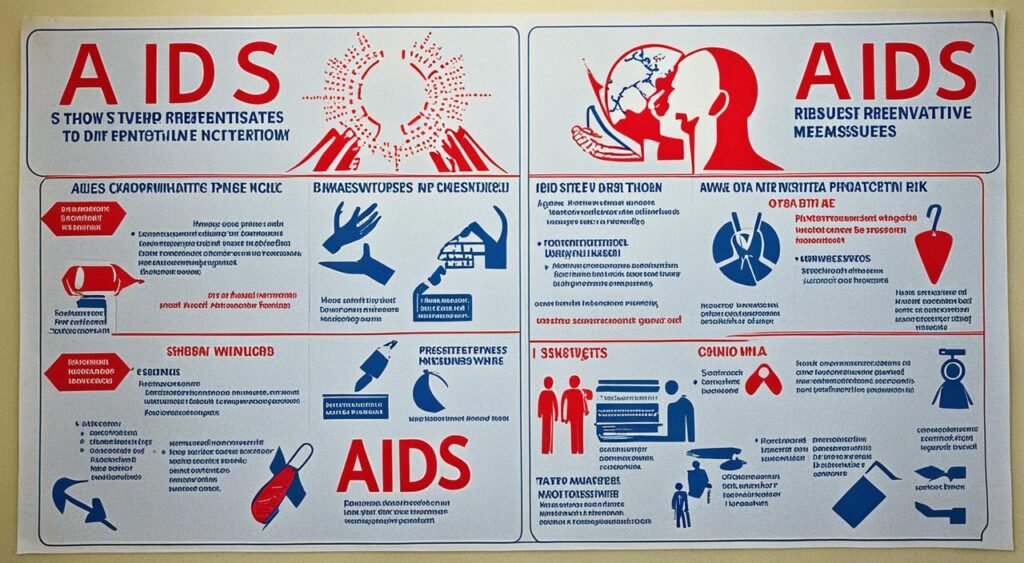HIV is a virus that weakens the body’s ability to fight off sickness. It spreads through certain body fluids like blood, semen, and breast milk. This usually happens during sex without a condom or through sharing needles for drugs.
If someone has HIV and doesn’t get treatment, it can turn into AIDS. AIDS is a very serious condition that makes it hard for the body to fight off infections. Unfortunately, there’s no cure for HIV yet.
Key Takeaways
- HIV is a virus that attacks the immune system and can lead to AIDS if left untreated.
- HIV is primarily spread through unprotected sex or sharing injection drug equipment with someone who has HIV.
- There is no cure for HIV, but effective treatment can suppress the virus and prevent transmission.
- Getting tested and treated for HIV as soon as possible is crucial for managing the infection and staying healthy.
- Prevention methods like condoms, PrEP, and PEP can significantly reduce the risk of HIV transmission.
What Is HIV?
HIV stands for human immunodeficiency virus. It’s a virus that attacks the body’s infection-fighting cells. This makes a person more likely to get other infections and diseases.
It spreads mainly through certain bodily fluids. This happens during unprotected sex or by sharing needles for drugs. Without treatment, it can lead to AIDS.
The Basics of HIV
The human body can’t clear HIV on its own. There’s no cure yet for HIV. However, we have HIV medicine, called antiretroviral therapy (ART). This treatment is very effective.
With ART, the amount of HIV in the blood drops a lot. This is called viral suppression. If a person keeps their viral load undetectable by taking their medicine, they can live a long, healthy life. They also won’t pass HIV to their partners through sex.
How HIV Attacks the Immune System
HIV attacks and kills our CD4 cells. These are vital for a strong immune system. As more CD4 cells die and the virus spreads, our immune system gets weaker. This makes us susceptible to more illnesses.
HIV Treatment and Management
ART is key for longer, healthy lives for people with HIV. It also lowers the risk of passing the virus to others. If taken right, ART can make the virus in the blood undetectable.
This means there is practically no risk of spreading HIV to sexual partners. But remember, taking your medication on time and following up with doctors is crucial.
What Is AIDS?

AIDS is the final stage of HIV, where the immune system is severely harmed. In the U.S., many with HIV stay healthy by using HIV medicine properly. This stops the virus from causing AIDS.
Defining AIDS
Reaching AIDS means the CD4 cell count drops below 200. These are white blood cells that fight infections. Or, AIDS may be diagnosed if the person gets certain infections, even with a higher CD4 count. These are illnesses that show up if the immune system is very weak.
Progression to AIDS
Untreated HIV can wreck the immune system, leading to AIDS. The time it takes varies but is usually 8-10 years. However, with the right treatment, most people avoid getting AIDS.
Life Expectancy Without Treatment
Those with AIDS and no treatment have a tough road ahead. They typically live 3 years after diagnosis without HIV medicine. Once they catch a dangerous illness, survival drops to about 1 year.
How Do I Know If I Have HIV?
The only way to confirm HIV is by getting tested. This process is simple and available through many sources. Health providers, clinics, and hospitals offer HIV tests. If your test shows positive, you can start treatment right away.
HIV Self-Testing
Another choice is HIV self-testing. It lets you test at home and see your results alone. This method gives you the power to manage your health and know if you need care and treatment.
Understanding HIV Transmission
Transmission of HIV happens when certain fluids from an infected person enter someone else’s body. This often occurs during sex without protection, when sharing needles for drugs, or from an infected mother to her baby. Knowing how HIV spreads is key to stopping it from spreading.
Bodily Fluids and HIV Transmission
HIV can move from one person to another through blood, semen, and other fluids. It doesn’t spread through actions like kissing, sharing food, or using a toilet. It’s important to avoid certain body fluids to stop HIV from spreading, especially during sex or when sharing needles.
Routes of HIV Transmission
The main ways HIV spreads include:
- Unprotected sexual contact (vaginal, anal, or oral) with an HIV-positive person
- Sharing drug needles with an HIV-positive individual
- From an HIV-positive mother to her child during pregnancy, birth, or breastfeeding
Remember, you can’t get HIV from everyday contact, like hugging someone with HIV, sharing a meal, or using the same bathroom.
Undetectable = Untransmittable
Thanks to better HIV treatment, the idea that “Undetectable = Untransmittable” (U=U) is true. This means people living with HIV who take their medication and have a very low HIV level in their blood can’t give the virus to others through sex. This fact has made a big impact in HIV transmission prevention and has lessened the shame around the virus.
Symptoms of HIV and aids

It’s key to know the symptoms of HIV and AIDS. This helps spot the infection early and get treatment fast. HIV has different stages, each with unique signs.
Early Symptoms of HIV
In the first stage, called acute HIV infection, flu-like signs might show up. This happens 2 to 4 weeks after getting the virus. You could have a fever, feel tired, your lymph nodes might swell, your throat could hurt, and you might get a rash. This group of signs is known as “acute retroviral syndrome.” But not everyone gets these early warnings. Some people might have no symptoms for a long time after getting HIV.
Asymptomatic HIV
After the early symptoms, HIV can go into a silent stage. Those with HIV may not feel or show any symptoms. Because of this, 13% of those with HIV in the U.S. don’t know they are infected. Testing is super important during this quiet phase. It helps find HIV early and start treatment.
Late Stage HIV and AIDS Symptoms
Without treatment, HIV can lead to AIDS. By this time, the immune system is badly weakened. This makes those with HIV open to many serious infections and cancers. Signs in the final stages can include a cough that doesn’t go away, trouble breathing, losing a lot of weight, and other dangerous health issues. Starting treatment early is key to avoiding AIDS and keeping your immune system strong.
Opportunistic Infections and aids

Without treatment, latent infections can become serious threats to those in stage 3 of HIV. These are known as opportunistic infections. They often signal the presence of stage 3 HIV.
Common Opportunistic Infections
Opportunistic infections include candidiasis, coccidioidomycosis, and cryptococcosis. Additionally, there are cytomegalovirus disease, herpes, tuberculosis, and recurrent pneumonia. These diseases are life-threatening for those with severe HIV/AIDS because of their weakened immune system.
Life-Threatening Infections in AIDS
Without antiretroviral therapy, these infections become deadly in AIDS patients. The weakened immune system in AIDS means the body struggles to fight infections. This struggle can lead to fatal results without proper care.
HIV and AIDS: Global Impact
The world has felt the HIV and AIDS epidemic’s impact. However, some places are hit harder. Sub-Saharan Africa is the most affected area, with many people living with HIV. More than a third of adults in certain African parts have HIV.
Sadly, the HIV epidemic is found in many regions. South and Southeastern Asia have also seen many cases. In Eastern Europe, numbers are rising, mainly due to drug use.
| Region | Estimated Number of People Living with HIV | Percentage of Global Total |
|---|---|---|
| Sub-Saharan Africa | 28.2 million | 67% |
| South and Southeastern Asia | 5.9 million | 14% |
| Eastern Europe | 1.7 million | 4% |
The global HIV and AIDS problem deeply affects communities, health systems, and economies. Knowing where HIV is most present helps focus global health work. It helps to direct resources to face this severe public health issue.
Prevention and Managing Risk of aids

Stopping HIV spread and lowering the AIDS risk is key for public health. There are important ways to do this. These include using condoms for safer sex, taking PrEP if at high risk, and using PEP after a possible exposure.
Pre-Exposure Prophylaxis (PrEP)
PrEP is daily medicine for those with a high chance of getting HIV. This includes people in relationships where one has HIV or those who have unstable sex lives. It’s proven to be effective at stopping HIV transmission when taken accurately.
Post-Exposure Prophylaxis (PEP)
If you might have been exposed to HIV, taking PEP within 72 hours can help. This is a course of antiretroviral therapy to stop the virus from causing an infection. It’s beneficial for various people, like healthcare workers and those who have been assaulted sexually.
By using these methods and making sure people can test for and treat HIV quickly, we move forward in combating the HIV/AIDS epidemic. Everyone can play a part in protecting their sexual health and well-being.
Also read: Top 10 Cancer Hospitals For Best Treatment
Conclusion
This article covers key facts about HIV and AIDS, like how the virus works, its stages, and ways it spreads. We’ve also talked about the symptoms, global effects, and how to stop it. Remember, getting tested for HIV is crucial. We have good treatments now that help people live healthily. But, the fight against the fear of HIV and AIDS still goes on.
Even though there’s no cure, getting treatment for HIV is much better today. Early diagnosis and treatment help a lot. People can live long, healthy lives. It’s also proven that if the virus is ‘undetectable,’ it can’t be passed to others.
The push to fight HIV is not over. We need to keep helping to stop its spread, improving care access, and fighting shame. By joining forces, we aim to end HIV and AIDS. Our goal is for everyone with HIV to find the help they need and to live well.
FAQs
Q: What is AIDS?
A: AIDS stands for Acquired Immunodeficiency Syndrome, which is a chronic and potentially life-threatening condition caused by the Human Immunodeficiency Virus (HIV). AIDS weakens the immune system, making the body more susceptible to infections and other complications.
Q: How does HIV spread?
A: HIV is primarily spread through contact with certain body fluids such as blood, semen, vaginal fluids, and breast milk. The most common modes of transmission include unprotected sexual contact, sharing of needles among injection drug users, and from mother to child during pregnancy, childbirth, or breastfeeding.
Q: What are the symptoms of AIDS?
A: The symptoms of AIDS vary depending on the stage of the infection. Common symptoms may include rapid weight loss, recurring fever, extreme and unexplained tiredness, prolonged swelling of the lymph glands, and opportunistic infections that occur due to a weakened immune system.
Q: How can HIV be detected?
A: HIV can be detected through various tests that look for the presence of HIV antibodies or the virus itself in blood or other body fluids. Common tests include HIV antibody tests, antigen/antibody tests, nucleic acid tests, and CD4 count tests.
Q: What is the risk of transmitting HIV?
A: The risk of transmitting HIV can occur through unprotected sexual intercourse, sharing needles or syringes, mother-to-child transmission during pregnancy or breastfeeding, or exposure to infected blood. It is important to practice safe sex, use sterile needles, and get tested regularly to reduce the risk of transmission.
Q: How can HIV be prevented?
A: HIV transmission can be prevented by practicing safe sex, using condoms consistently, avoiding sharing needles or injection equipment, getting tested regularly, and seeking early treatment if diagnosed with HIV. Pre-exposure prophylaxis (PrEP) and post-exposure prophylaxis (PEP) are also preventive measures available for those at risk of HIV.
Q: What are the latest advancements in HIV medication?
A: The field of HIV treatment has seen significant advancements in recent years, with the development of antiretroviral therapies that effectively suppress the virus and improve the quality of life for individuals living with HIV. New medications are continuously being researched and developed to enhance treatment outcomes and reduce side effects.
Source Links
- https://www.hiv.gov/hiv-basics/overview/about-hiv-and-aids/what-are-hiv-and-aids
- https://www.webmd.com/hiv-aids/understanding-aids-hiv-basics
- https://www.medicalnewstoday.com/articles/17131





